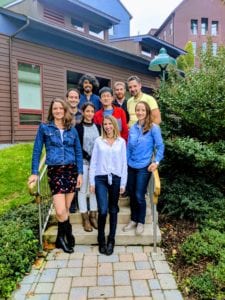By Daniel Dunaief
Fidgeting, rocking and other movements may have some benefit for thinking. Yes, all those people who shouted to “sit still” may have been preventing some people from learning in their own way.
In a new experiment conducted on mice published in the journal Nature Neuroscience this week, Anne Churchland, an associate professor at Cold Spring Harbor Laboratory, linked idiosyncratic mouse movements to performance in a set of tasks that required making decisions with rewards.
“Moving when deep in thought is a natural thing to do,” Churchland said. “It deeply engages the brain in ways that were surprising to us.”
She suggested that many people believe thinking deeply requires stillness, like the statue of The Thinker created by Auguste Rodin. “Sometimes it does, but maybe not for all individuals,” adding that these movements, which don’t seem connected to the task at hand, likely provide some benefit for cognition.
“We don’t know yet for sure what purpose these movements are serving,” she said.

Mammals tend to exhibit a process called “optimal motor control.” If a person is reaching out to grab a cup, she tends to move her arm in a way that is energy conserving. Indeed, extending this to her rodent study, Churchland suggests that somehow these ticks, leg kicks or other movements provide assistance to the brain.
In theory, she suggested that these movements may be a way for the brain to recruit movement-sensitive cells to participate in the process. These brain cells that react to movement may then participate in other thought processes that are unrelated or disconnected from the actions themselves.
Churchland offers an analogy to understanding the potential benefit of these extra movements in the sports world. Baseball players have a wide range of stereotyped movements when they step up to the plate to hit. They will touch their shirt, tug on their sleeves, readjust their batting gloves, lift up their helmet or any of a range of assorted physical activities that may have no specific connection to the task of hitting a baseball.
These actions likely have “nothing to do” with the objective of a baseball hitter, but they are a “fundamental part of what it means to go up to bat,” she said.
In her research, Churchland started with adult mice who were novices at the kinds of tasks she and her colleagues Simon Musall and Matt Kaufman, who are the lead authors on the paper, trained them to do. Over a period of months, the mice went from not understanding the objective of the experiment to becoming experts. The animals learned to grab a handle to start a trial or to make licking movements.
These CSHL researchers tracked the behavior and neural activity of the mice every day.
Churchland said a few other groups have measured neural activity during learning, but that none has studied the kind of learning her lab did, which is how animals learn the structure of an environment.
The extra movements that didn’t appear to have any connection to the learned behaviors transitioned from a disorganized set of motions to an organized pattern that “probably reflected, in the animal’s mind, a fundamental part of what it means to make a decision.”
Churchland suggested that some of these conclusions may have a link to human behavior. Each animal, however, has different behaviors, so “we always need to confirm that what we learn in one species is true for another,” she wrote in an email.
Parents, teachers, coaches and guest lecturers often look at the faces of young students who are shaking their legs, rocking in their chair, twiddling their thumbs or spinning their pens between their fingers. While these actions may be distracting to others, they may also play a role in learning and cognition.
The study “suggests that allowing certain kinds of movements during learning is probably very important,” Churchland said. “When we want people to learn something, we shouldn’t force them to sit still. We should allow them to make movements they need to make which will likely help” in the learning process.
Churchland believes teachers already know that some students need to move. These educators also likely realize the tension between allowing individual students to be physically active without creating a chaotic classroom. “Most teachers are working hard to find the right balance,” she explained in an email.
She also suggested that different students may need their own level of movement to stimulate their thinking.
Some adults may have already developed ways to enhance their own thinking about decisions or problems. Indeed, people often take walks that may “finally allow those circuits you need for a decision to kick in.”
Down the road, she hopes to collaborate with other scientists who are working with nonhuman primates, such as marmosets, which are new world monkeys that live in trees and have quick, jerky movements, and macaques, which are old world monkeys and may be familiar from their island perch in an exhibit in the Central Park Zoo.
Churchland said extensions of this research could also go in numerous directions and address other questions. She is hoping to learn more about attention deficit hyperactivity disorder and the brain.
“We don’t know when that strategy [of using movement to trigger or enhance thinking] interferes with the goal,” she said. “Maybe the movements are a symptom of the learner trying to engage, but not being able to do so.”
Ultimately, Churchland expects that different pathways may support different aspects of decision making, some of which can and likely are connected to movement.





